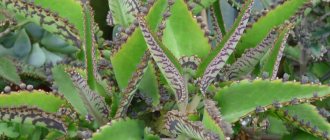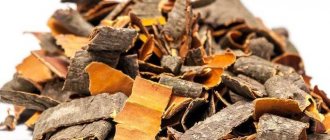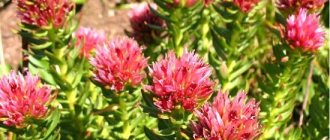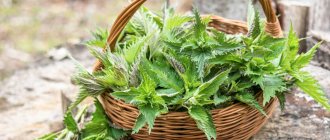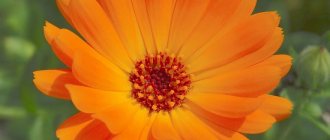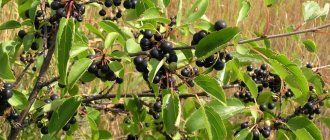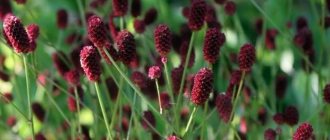Photo: UGC There are plants that have been successfully used in traditional medicine for thousands of years. One of them is marsh calamus. The magical properties of this wonderful herb were described by Hippocrates. Today it is successfully used in Ayurvedic, Chinese, and European medicine. What makes the plant so useful and effective, and why should it be used with caution? I will talk about this in the article.
Chemical components
Traditional healers claim that the roots of common and marsh calamus can help cure a number of diseases. Collection for these purposes is carried out in the autumn and spring periods. One of the characteristics of the plant is a large amount of essential oil in its composition, which gives it a number of useful and pleasant properties. Calamus oil is rich in:
- asarone;
- borneol;
- calameol;
- beta-pinene;
- element;
- akoron;
- turmeric.
In addition, there are other substances that have a positive effect on the body. Although asarone is considered the root component, besides it you can find in the grass:
- Starch . Contains carbohydrates, which are a useful source of energy. There is a positive effect on digestive processes.
- Vitamin complex . The plant is rich in vitamins A, C, K, E and PP, as well as the entire group B. They are indispensable for various processes occurring in the body. Most of it supports vision, promotes the functioning of the gastrointestinal tract, urinary organs and the reproductive system as a whole.
- Kholin . Vitamin B4, necessary for organizing the correct functioning of the central nervous system. This herb is contained in sufficient quantities, which makes it possible to create a line of special sedatives based on calamus. It is widely used among traditional methods of treatment.
- Iodine . Without this chemical element, proper functioning of the thyroid gland is not possible. The inhabitants of the northern expanses of Russia are often susceptible to iodine deficiency, which is why traditional medicine advises collecting and using calamus as a means of replenishing this substance.
- Tannins . Certain components are present in every second plant and calamus is no exception. They have a positive effect in the treatment of diseases of the digestive system. In addition, these substances have wound healing and anti-inflammatory properties.
- Ascorbic acid . An abundance of vitamin C, which is involved in building the body's defenses. With a deficiency, the risk of catching a cold or the flu increases, and in more advanced cases, another serious pathology.
- Palmitic acid . It is one of the main components of palm oils. The component is widely used in the cosmetology field. It helps accelerate healing processes, relieves irritation, eliminates skin flaking and participates in restoring the structure of damaged hair.
Indications for use
What can remedies made from calamus root help to cure? The list of diseases is very wide:
- Joint diseases.
- Diseases of the gastrointestinal tract (stomach ulcer, cholecystitis, gastritis, diarrhea).
- Diseases of the upper respiratory tract (sore throat, pneumonia, laryngitis, bronchitis, pharyngitis).
- Circulatory system disorders (varicose veins, hypertension, thrombosis, thrombophlebitis).
- Skin diseases (pustules, ulcers, cracks, fungal skin diseases).
- Nervous system disorders (depression, neurosis, mental disorders).
- Diseases of the genitourinary system (menstrual irregularities, inflammatory processes, prostatitis, urolithiasis).
Type and places of growth
This species is not an annual species. Approximately six varieties have been identified, but only two are recognized in official sources. There you can also find the names ordinary and cereal. It grows on the banks of fresh water, but is also found near swamps and small streams . It was the habitat that gave the grass its characteristic name.
Calamus is fruitful. Its fruit can be red or green. Botanists put forward the version that the grass came to Europe not without the help of importation. History knows the facts of the use of roots by Mongol-Tatar soldiers - they placed them in a pond. It was believed that calamus would help make the liquid safer by purifying it and preparing it for ingestion. For this reason, another popular name “Tatar potion” was established.
The marsh calamus has the ability to take root, which gave it the opportunity to spread to all corners of Europe. The grass looks like a small shrub, with a height not exceeding 1.6 meters. More often, the height of the bush is about 1.2 meters.
The leaves are bright green in color, can grow up to a meter in length and three centimeters in width, and are xiphoid in shape. The growth is fan-like, on top of the root. The spicy marshy smell is a striking difference between calamus and other related plants. The European population of the Russian Federation calls it marsh cinquefoil, due to its appearance.
The root can grow up to one and a half meters . Its surface has a dark crust that hides the light pinkish flesh. Its taste is bitter, but it is quite edible. The smell of the root can be compared to a mixture of tangerine and cinnamon.
The stem shape is straight. It is equipped with clearly defined sharp edges resembling a blade. The flowers are highlighted in yellow and are contained in a quantity of at least eight per inflorescence. They grow from the central point of the leaf.
Description, reproduction and distribution area of common calamus
Coastal aquatic perennial herbaceous plant of the aroid family (Agaceae), up to 1 m or more in height.
The rhizomes are creeping, horizontal, branched, up to 3 cm in diameter, up to 1.5 m long, brownish or greenish-yellow on the outside, with numerous white, cord-like roots below, reaching a length of 50 cm, with large semi-lunar leaf traces on top. The rhizomes are located almost at the soil surface, less often at a depth of 10 cm.
The leaves are basal, up to 3 cm wide, bright green, fleshy, sword-shaped, pointed, located on the tops and lateral branches of the rhizomes. The leaves and rhizomes have a characteristic fragrant odor and bitter taste.
Small roots have no smell.
Flowering stems are in small quantities, up to 80 cm high, flattened, having a groove on one side and a sharp edge on the other.
The inflorescence is a cylindrical spadix, slightly narrowed at the top, 4-12 cm long and 1-2 cm thick, located in the upper part of the flowering stem.
The flowers are small, greenish-yellow, bisexual, densely crowded in a spadix deflected to the side. The ovary is superior, trilocular.
The fruit is a leathery, oblong, multi-seeded red berry.
Blooms from May to July.
It propagates both by seeds and vegetatively by the growth of rhizomes.
Distributed in the European part of the CIS, Central Asia, Siberia and the Far East. Due to the draining of wetlands, natural thickets are greatly reduced. It grows along the banks of slowly flowing rivers, streams, lakes, ditches, along quiet backwaters, river oxbows, and often forms continuous thickets, pure or mixed with horsetails and sedges.
The generic name comes from the Greek akoros - a plant with a creeping rhizome. The specific definition is derived from the Greek kalamos - reed, reed, due to its similarity with the latter.
The homeland of calamus is China and India.
Collection and storage
Harvesting marsh calamus should begin in early autumn or spring . You can collect the plant using a regular rake, since it is too difficult to try to do it with your bare hands. The rhizome is separated from the flowering part and stem and washed. The resulting components need to be laid out in the open air for a couple of days to dry completely.
After complete drying, the root must be divided into parts, each of which is no more than twenty centimeters in length. In a situation where the roots are of considerable thickness, they need to be split. This allows you to make the preparation and drying process much faster, as well as increase storage time.
The prepared part of the roots is placed in a container with an iron top and left to mature at thirty-five degrees. It is extremely important not to exceed this value. Otherwise, the process of evaporation of essential oils will begin. At the end, the product will be practically useless.
In the process, try to break the rhizome . If this does not require much effort, then the product is ready for further processing. It can be placed in a glass container or a fabric bag. Storage is carried out in dark, dry and cool places. The average time when calamus does not lose its properties during storage is one year.
The finished raw material is light in weight and yellowish-brown in color, while the pulp acquires a white or pink tint.
Medicinal raw materials
In nature, rhizomes are harvested in the summer-autumn period (June - September), when the swamps dry up and the groundwater level drops. In this case, the calamus is dug out with a pitchfork with curved teeth or pulled out with a rake. It must be taken into account that natural thickets are restored slowly, so you need to dig up the roots selectively, removing no more than 30% of the total number of plant shoots in each thicket. The collected rhizomes are cleaned of muddy residues, roots and dry parts. Long rhizomes are cut into pieces of 20-30 cm, and thick ones are additionally split longitudinally. Sometimes the bark, the cork layer, is removed from them. It turns out two types of raw materials: purified and unrefined. However, unrefined calamus is much more flavorful.
Next, the prepared pieces of calamus rhizome are dried in warm, dry, well-ventilated rooms, where they are laid out in a thin layer. When using a dryer, the temperature should not exceed 30-35°C. Higher temperatures reduce the quality of the raw material - the essential oil evaporates. The end of drying is determined by the fragility of the pieces.
The shelf life of raw materials is 1 year.
The healing effect of calamus roots
The composition of the plant allows it to be used for treatment purposes. Among the beneficial properties of calamus are :
- Vasodilation, which restores blood pressure.
- Elimination of acute pain - the plant is also an excellent pain reliever.
- Relieves spasms, which become the starting point for pain. The active substance eliminates spasms in muscles and all internal organs, which helps alleviate the patient’s condition.
- Antibactericidal action. A number of special substances in the herb have an antimicrobial effect, destroying the pathogenic microorganism and slowing down its logistics throughout the body.
- Restores the proper functioning of nerve centers. With this property, this type of herb can be used in the treatment of neurological disorders, including depressive conditions.
- Stops bleeding. A remedy based on marsh calamus can be used to stop internal and external bleeding, which is extremely dangerous to human health - they can lead to anemia, low blood volume, which will certainly worsen the condition.
In addition to all of the above, the plant has astringent properties. In general, it can be used to increase tone. These are also used by chefs who add herbs to various dishes.
For women
Traditional healers recommend using calamus to make products to combat fibroids.
The plant is beneficial for women's health due to the fact that it has a high restorative effect on hormonal levels. The course of therapy allows you to see a favorable state of the body, a decrease in the intensity of the symptom or its complete disappearance. But you need to start treatment immediately, at an early stage of the disease.
For men
The roots of the marsh plant are also beneficial for men. In addition to its therapeutic effect, we note that calamus is an aphrodisiac.
Medicinal assemblies based on this herb have a general positive effect in the treatment of the reproductive system. The root can not only increase potency, but also help improve overall tone, reducing the risk of developing diseases such as prostate adenoma. Calamus improves the quality of semen, which increases the efficiency of reproductive functions. Suitable for the treatment of infertility.
Medicine and marsh grass
Traditional healers have identified a number of diseases that the plant copes with:
- Gastrointestinal diseases . Calamus will restore lost appetite, help with stomach upsets, intestinal colic, diarrhea and flatulence, as well as many other diseases. Successfully eliminates spasms and relieves pain. It has an enveloping effect that reliably protects the gastrointestinal tract from a number of factors. Also, medicines based on it have the properties of reducing acidity.
- ARVI and influenza . In this case, it is used to make decoctions and tinctures to fight colds - calamus perfectly removes phlegm from the bronchi. In addition, the drugs can be taken for preventive purposes.
- Cardiovascular pathologies . It is used when a painful sensation occurs in the chest area, dilated vascular walls. Increases tone.
- Diseases of the central nervous system . A number of active substances in the herb will help overcome stress and depression. The medicine is a mild sedative.
- Headache . Calamus helps in eliminating recurring headaches, especially those caused by high blood pressure.
- Poisoning , including hallucinogenic substances. This plant easily copes with intoxication by hallucinogenic substances in the shortest possible time, neutralizing their effect.
- Male pattern baldness . Trouble for men over thirty-five. Regular use of the decoction allows you to preserve your hair.
- Male infertility . Improving the composition of semen and the overall effect can cure and prevent prostate adenoma.
- Tuberculosis . Plants are recommended when determining the disease, as it can help neutralize the action of pathogenic microflora. It also helps speed up recovery.
- Rheumatism . The roots of this plant eliminate the entire list of unpleasant sensations inherent in this pathology.
- Liver diseases . Various calamus-based remedies can reduce the negative effects on the liver.
In addition to those indicated in the list, there is an additional range of applications: for painful menstruation, to improve secretory function and to relieve heartburn.
During menopause
Calamus infusions help stop the onset of menopause. After completing a course of therapy, a woman will feel a significant improvement in her overall health. The hot flash disappears, the central nervous system returns to normal, attacks of irritability stop, depression recedes and overall mood improves.
For potency
This property is due to the components included in the composition, which also help improve sperm quality. As a result, reproductive capacity is significantly increased.
For teeth
Calamus roots are useful in treating gum inflammation and tooth pain. It stops bleeding and relieves pain. It is recommended to use for the prevention of oral diseases. A decoction is used to rinse the mouth every day, ideally after every meal. Pleasant properties include improving bad breath and relieving inflammation.
For gastritis
The ordinary and marsh varieties are recognized by folk medicine as the most effective means of preventing and treating gastrointestinal diseases. Reduces the risk of ulcers. Thanks to the high enveloping effect, a similar property is achieved.
The active substance will protect the intestinal mucosa, not only preventing the action of a negative factor, but also stopping the inflammatory process entirely. However, such treatment requires consultation with a gastroenterologist.
Fighting nail fungus
The tincture of the plant's root has a strong antimicrobial effect, which makes it possible to use it in the treatment of nail fungus. It is applied to the nail plate and surrounding area.
Treatment will take a couple of weeks, a month at most. However, after the course, the nails will look healthier and the symptoms will disappear.
For vision
Traditional medicine has a rich collection of recipes that help improve and maintain vision and the functioning of the visual organs, in general. They are prepared based on the symbiosis of calamus and calendula.
The healing properties of the plant make it possible to restore eye pressure, normalize blood circulation in the eyes, and relieve fatigue. It also helps strengthen the retina and normalizes tear fluid.
When smoking
Traditional methods of getting rid of tobacco addiction note the effectiveness of this root. The recipe is simple - you need to chew pieces of dried roots. This reduces cravings. And when used together with mint, you can achieve double the effect.
For pancreatitis
When such a diagnosis is made, you can immediately proceed to the use of calamus in powder form. The product helps improve bile synthesis and its permeability. In addition, there is a restoration of acidity levels.
The powdered root is taken orally - a small volume, literally at the end of a spoon, is kept in the mouth, and then washed down with a mug of water.
For sore throat
A fresh decoction or tincture based on the root helps get rid of the disease. It destroys pathogenic microorganisms, relieves pain and eliminates inflammatory processes.
Healing compositions with calamus
Calamus, like calamus, is used as a base for many medicinal products.
Tincture
To prepare the infusion you need twenty grams of dried roots, which are crushed in a blender before cooking. The resulting mass is poured into a glass of boiled water. The container is covered with a lid and heated for no more than fifteen minutes in a water bath.
After which, the resulting cake and liquid are left for sixty minutes to infuse, and then brought to the initial volumes using the same boiled water. Fifty milliliters per day is consumed.
Use in the detection and prevention of stomach diseases, colds, intestinal and toothache.
Decoctions
This type is used for neurosis, excessive growth of the endometrium, migraine, and menstrual irregularities. Its preparation requires three teaspoons of dried roots and a glass of water. Place the container on the stove and boil for fifteen minutes. Take a third of a glass before meals.
Candied fruit
Calamus roots are used to prepare not only medicinal, but also very tasty products. Not only children, but also adults will definitely like them. Before preparing candied fruits, the syrup must be boiled. The roots are cut into small pieces and dipped into the finished syrup. Cook for five minutes.
After which, the pan is removed from the heat and left for exactly half a day. After 12 hours, you need to boil the pan again and leave for five minutes. The dried pieces are eaten.
Powder look
Suitable for treating wounds or ulcers, as well as runny nose. Dried root segments are ground into powder using a blender or coffee grinder. An excellent remedy for allergies. Together with honey, the effect against sore throat is enhanced.
Medicines, method of using calamus and recipes
Calamus oil is taken 2-4 drops 2-3 times a day with honey.
Aromatic water from calamus rhizomes is used to treat periodontal disease and other inflammatory processes of the oral mucosa, in gynecological practice for douching for colpitis of coccal and trichomonas etiology, for hypermenstrual syndrome, secondary aminorrhea, ovarian failure and pathological menopause.
ATTENTION! Dosage forms of calamus should not be used during pregnancy.
- Recipes for single use of anise in medicine
- Recipes for using common anise in preparations
Cosmetology
The root is used in home cosmetic kits to prepare hair care products. They relieve a wide range of problems, for example, peeling skin and hair loss. Each prepared infusion or decoction gives the curl shine, restores the thickness of the strand and a pleasant overall appearance.
There are a number of standard recipes:
- Decoctions for strengthening hair . It is prepared as follows: prepare four tablespoons of root powder and a liter of boiled water. All this is sent into a container, which is covered with a lid. The decoction is infused for two to three hours. The products can be used in two ways: rinsing the head and rubbing into the skin. You can dilute the recipe with crushed hop cones in the amount of one tablespoon and burdock. The latter is also dried and crushed. The resulting product is extremely popular for combating baldness.
- Mouthwash . The ingredients are selected in any proportions. Swamp calamus, dried or crushed, is poured with boiling water. After which, the product settles for about two hours and strains through a sieve. Apply after every hair wash.
- Anti-hair loss mask . A separate container is filled with two and a half hundred grams of crushed roots, half a liter of table vinegar and sent to cook on the stove over low heat. Time - fifteen minutes. Immediately after boiling, add three tablespoons of clean water and mix the resulting mixture. The mask is applied to the hair over the entire length. But wait until it cools down before applying.
- Facial rinses . The products will help get rid of excess fat and restore the natural color. To prepare, you need to take two tablespoons of ground roots. They are filled with a liter of boiling water, after which the container must be closed with a tight lid and put in a dark place for three hours. The resulting decoction is applied to the face; this can be done in the morning and before bed. The shelf life of the product is no more than two days in the refrigerator.
Use in cooking
Ordinary calamus can be used not only as a remedy for most pathologies or caring for the beauty of skin and hair. It is widespread in the culinary world. Calamus is used to prepare specific dishes. It itself serves as a seasoning, which has long been a tradition when preserving fish. Moreover, calamus is also found in alcoholic drinks.
The leaves are suitable for making jam - they will give it an indescribable aroma. It is a kind of replacement for pepper, cinnamon and nutmeg.
Oils obtained from plant roots are used in the production of alcohol. It is because of this that Western Europe has been growing this plant on an industrial scale for a long time.
In addition, calamus is found in:
- Salatah . Only young inner foliage is used. It is cut into strips and placed on a plate. Sour cream, chopped onions and salt are also added there. All this is filled with syrup. The result is not only a tasty, but also healthy salad.
- Candied fruits . Great substitute for dessert. First, you need to prepare the syrup. Pre-crushed root segments are also dropped there. It is important that each piece does not exceed four, maximum five centimeters in length. The root is dipped in boiling syrup for ten minutes, after which it is removed and dried. For storage, candied fruits are placed in a glass container and placed in a dry place.
- Pancakes . A traditional dish is prepared from plant powder. It is added to the pre-prepared dough and kneaded with it. Pancakes, as in any other case, are baked in vegetable oils.
- Kvass . To begin with, prepare the most ordinary kvass, then a decoction of calamus root. To prepare the latter, four tablespoons of root powder are poured with boiling water and simmered over low heat. Boiling is carried out for fifteen minutes. The resulting mixture is added to kvass in accordance with the proportion: one glass of broth per three liters of kvass.
Using calamus in cooking fills dishes with a special smell and taste. But, at the same time, a number of medicinal properties remain with it, helping to reduce the possibility of a cold. The result is a double advantage.
Growing on site
Despite the ingrained opinion of calamus as an exclusively wild plant, it is a rewarding crop for growing on site.
This plant prefers moist and waterlogged soils and is a coastal aquatic species. Grows in stagnant and slowly flowing waters with a neutral water reaction (pH 6.8-7.2) on silty, sandy, peaty and alluvial soils.
If you don’t want to bother with creating your own reservoir, then calamus will grow well in the garden; it is not as demanding on moisture as is commonly believed. To do this, in early spring or in the second half of summer, bring pieces of rhizomes with 1-2 buds from natural thickets. The rhizomes are planted in a previously prepared and fertilized area with organic matter. The distance between plots is 10-20 cm in a row and 45-50 cm between rows. Soils with average mechanical composition are preferred. Sandy soils will dry out too quickly, and heavy loams will somewhat “suffocate” your plants.
Planting calamus is reminiscent of the propagation of irises, which is familiar to any gardener. For better survival during summer planting, its leaves are shortened by 2/3.
When planting and for the first time after it, watering is advisable. But established plants survive without watering even during very dry periods, such as last summer. If you fail to come and water the plants for 2-3 weeks, then this is not fatal for them, however, growth also stops.
Care includes timely weeding and, in the first years, surface loosening. The annual growth of one rhizome is only 10-70 g. You can dig up rhizomes 3-4 years after planting. It is better to combine this with a transfer to a new place. After 4 years, even with careful care, calamus begins to sprout perennial root shoot weeds and it becomes increasingly difficult to weed them out. The harvest is 4-5 kg per 1 sq. m.
The plant is not affected by pests and diseases.
In decorative gardening, the plant itself is not very impressive, but due to its endurance it is convenient as a background plant when creating compositions. It tolerates waterlogging, drafts and cold well. Calamus is best suited for decorating wetland compositions, but as mentioned above, it grows well far from a body of water.
Contraindications for use
Plants, despite a number of their qualities, cannot be used as medicine in all cases due to the fact that they have contraindications:
- Pregnancy. The abundance of active substances can negatively affect the development of the child.
- Bleeding from the nose. This can be explained by the fact that medications based on calamus roots have a vasodilating effect, which in turn increases bleeding.
- Intestinal and stomach ulcers in acute forms.
- Increased acidity.
- Inflammation of the kidneys during the acute course of the disease.
- Individual intolerance by the body to a number of substances in the herb.
- Allergy to calamus. Expressed by the following symptoms: itching, rash, runny nose. It can lead to the formation of Quincke's edema, which can lead to anaphylactic shock. This condition is dangerous to human health.
In addition, ordinary calamus cannot be used for low blood pressure, as it lowers blood pressure.
Doctors also insist on avoiding the use of leaves and medicines based on them while breastfeeding. This is due to the possibility of allergies in the child.
From the above it can be understood that marsh calamus is one of the list of the most popular folk medicines. Various preparations based on it save from a large number of painful and unpleasant symptoms, and carry out the prevention and treatment of various pathologies.
Description
After the entire trunk has grown into leaves, the plates begin to grow together. The flowers of the houseplant calamus are yellow in color. After the flowering period, fruits appear. Animals begin to spread them throughout all areas. In some places the plant has lost its ability to bear fruit.
An amazing aquatic plant growing along the banks of reservoirs is found throughout the country. Loved by the peoples of the world for its extraordinary qualities. The marsh calamus has received many name variations.
Indian reed, calamus, sweet calamus, acorn root, Tatar potion - these are not all the names of calamus. It is generally accepted that it appeared in Rus' during the arrival of the Tatar-Mongols, who used the ability of calamus to purify water. To do this, the roots of the plant threw water.
